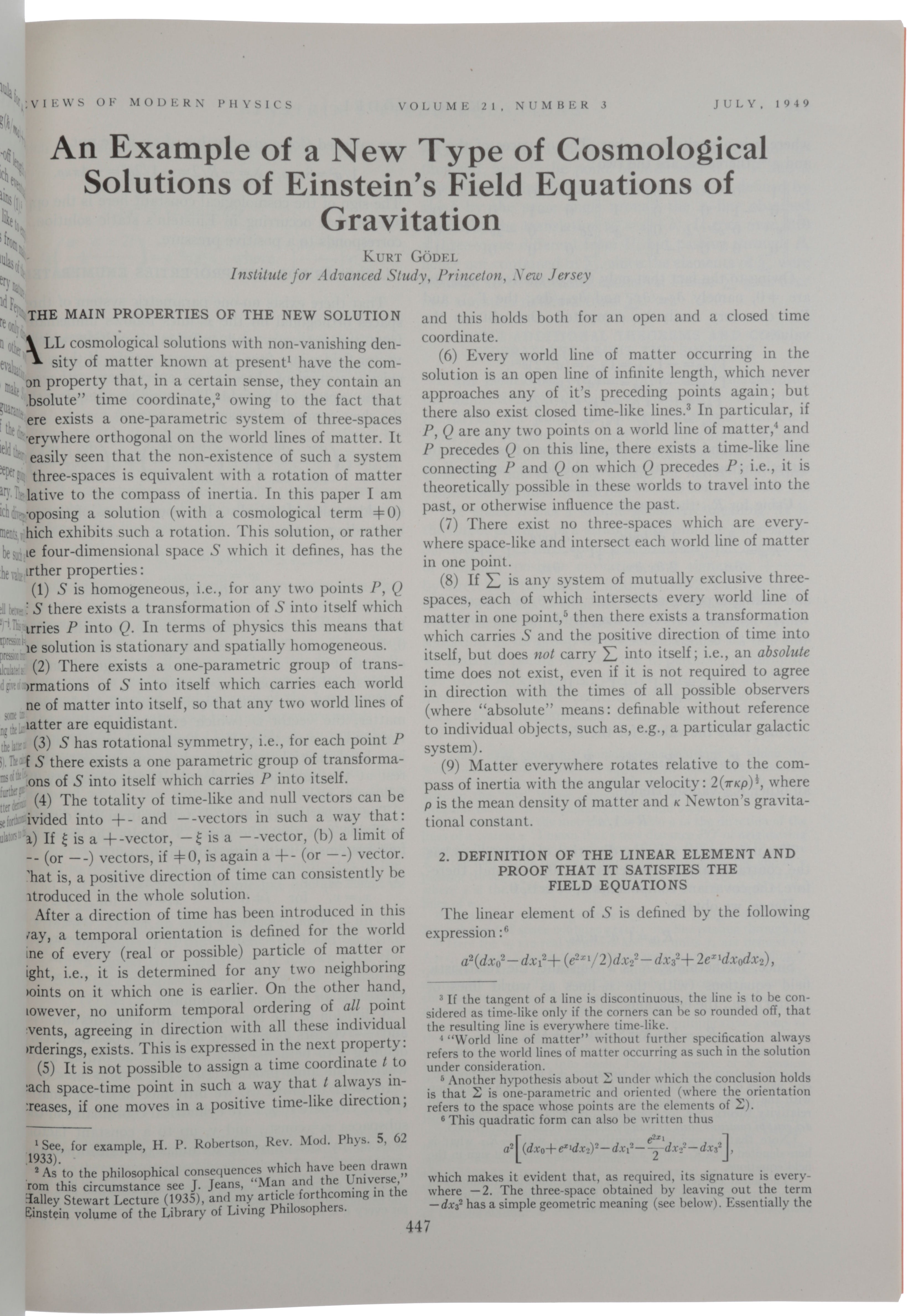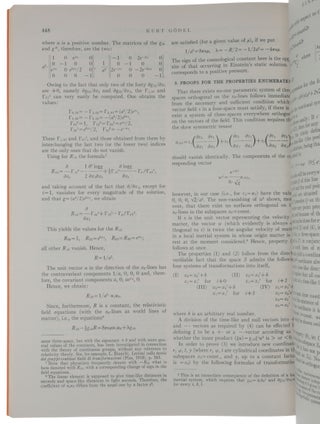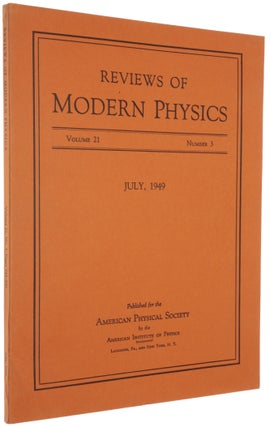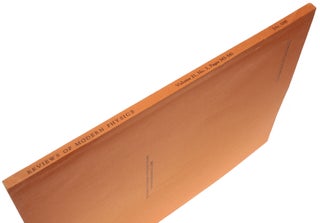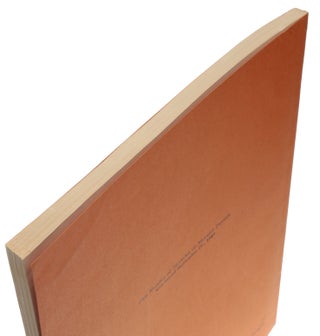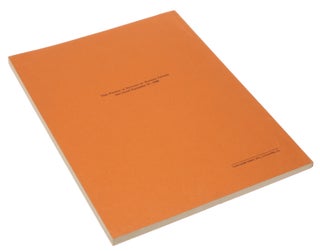‘An Example of a New Type of Cosmological Solutions of Einstein’s Field Equations of Gravitation,’ pp. 447-450 in Reviews of Modern Physics, vol. 21, no. 3, July-September, 1949.
Lancaster, PA: American Physical Society, 1949. First edition, journal issue, in original printed wrappers, of Gödel’s ‘time-travel paper,’ ‘one of the most important [papers] on relativity since my own original paper appeared’ (Einstein to Morgenstern, 1952). “In the 1920s and 1930s, the Friedmann-Robertson-Walker cosmological models had been introduced as the simplest solutions of the equations of Einstein’s general theory of relativity that were consistent with the observed red-shift of distant galaxies. These models were spatially homogenous and isotropic, and were expanding but were non-rotating. Gödel was the first to consider models that were rotating. The possible rotation of the universe has a special significance in general relativity because one of the influences that led Einstein to the theory in 1915 was Mach’s principle. The exact formulation of the principle is rather obscure, but it is generally interpreted as denying the existence of absolute space. In other words, matter has inertia only relative to other matter in the universe. The principle is generally taken to imply that the local inertial frame defined by gyroscopes should be non-rotating with respect to the frame defined by distant galaxies. Gödel showed that it was possible to have solutions of the Einstein field equations in which the galaxies were rotating with respect to the local inertial frame. He therefore demonstrated that general relativity does not incorporate Mach’s principle … In [the offered paper] Gödel presented a rotating solution that was not expanding but was the same at all points of space and time. This solution was the first to be discovered that had the curious property that in it it was possible to travel into the past. This leads to the paradoxes such as ‘What happens if you go back and kill your father when he was a baby?’ It is generally agreed that this cannot happen in a solution that represents our universe, but Gödel was the first to show that it was not forbidden by the Einstein equations. His solution generated a lot of discussion of the relation between general relativity and the concept of causality” (Stephen Hawking, p. 189 in Kurt Gödel: Collected Works: Volume II: Publications 1938-1974). “Gödel’s brilliant burst into the world of physics in 1949 came as a surprise to those who knew him “only” as one of the greatest logicians of all time and thus as a very pure mathematician. However, to his colleagues at the Institute for Advanced Study (IAS) in Princeton, it was less surprising. At IAS, he had famously befriended Einstein, and much earlier, before switching over to mathematics, he had even entered the University of Vienna (in 1924) as a physics student and attended lectures by Hans Thirring, one of the earliest protagonists of Einstein’s theories. Moreover, although this was not apparent from his published work, Gödel had maintained a lifelong interest in physics, attending the physics seminars at IAS and keeping abreast of ongoing developments. Then came the crucial trigger: the year 1949 brought Einstein’s seventieth birthday, and Gödel was expected to contribute to the planned Festschrift for his friend. Not for the first time did pressure prove conducive to invention” (Rindler, p. 185). Gödel’s Festschrift contribution, ‘A Remark about the Relationship between Relativity Theory and Idealistic Philosophy’ (pp. 557-562 in Albert Einstein: Philosopher-Scientist, P.A. Schilpp (ed.), 1949), appeared almost simultaneously with the offered paper. It treated the philosophical implications of Gödel’s model, while the offered work provides the technical derivation from the Einstein field equations. “Gödel stated that he was motivated to invent his model universe from sympathy for Kant’s philosophy of time. It was to serve as the first counterexample on the cosmic scale to the objective view of time, which treats time as an infinity of layers “now” coming into existence successively. By 1905, Einstein had already shown this view to be problematic with his special theory of relativity. Indeed, one of the greatest shocks delivered by that theory was the discovery that simultaneity is relative … The situation becomes even worse with the space-times of general relativity that correspond to real-life irregular matter distributions. Only in the idealized homogeneous-isotropic universes introduced by [Alexander] Friedman [‘Über die Krümmung des Raumes’ & ‘Über die Möglichkeit einer Welt mit konstanter negativer Krümmung des Raumes,’ Zeitschrift für Physik, 1922 & 1924] of which the 1917 static Einstein universe was a special case [‘Kosmologische Betrachtungen zur allgemeinen Relativitatstheorie,’ Sitzungsberichte der Königlich preussischen Akademie der Wissenschaften], do we find an absolutely (geometrically) determined worldwide time. These universes (except the Einstein universe) expand with a single expansion function, and their intrinsically determined time slices correspond to constant values of their steadily diminishing density. Thus the objective (or absolute) view of time got a reprieve from Friedmanian cosmology – which Gödel dismissed as accidental. His purported aim was to show that in more general cosmologies, no such objective time need exist” (ibid., p. 188). The idea for the particular model Gödel constructed probably arose from his reading of a paper by George Gamow (‘Rotating universe?’, Nature vol. 158, 19 October 1946, p. 549) which suggested that the whole universe might be in a state of uniform rotation and that this rotation might explain the observed rotation of galactic systems: “One of the most mysterious results of the astronomical studies of the universe lies in the fact that all successive degrees of accumulation of matter, such as planets, stars and galaxies, are found in the state of more or less rapid axial rotation. In various cosmogonical theories the rotation of planets has been explained as resulting from the rotation of stars from which they were formed. The rotation of stars themselves can be presumably reduced to their origin from the rotating gas-masses which form the spiral arms of various galaxies. But what is the origin of galactic rotation?” (abstract of Gamow’s paper). “Suddenly he had a problem worthy of his genius and the perfect gift for Einstein! However, that is not all. Gödel seems to have recognised that in a rotating universe, there would be no absolute time so that his Kantian ambition of superseding Friedman would also come true. Thus fortune placed in his hands not only a significant relativistic problem but one that even fell within his original Kantian program and that, when it was all done, would turn out to be far more beautiful than he could possibly have foreseen” (Rindler, p. 189). At the time Gödel wrote his papers on cosmology, “General relativity was Einstein’s new (now a century old) theory of gravity, in which Newton’s force of gravity is replaced by the curvature of four-dimensional space-time and where free matter moves along the natural rails of this curved space-time, namely, its geodesics … Our actual universe is, of course, lumpy … Instead one studies the smoothed-out version of actual universes and makes the assumption that the dynamics are effectively the same. The smoothed-out counterpart of any universe is its substratum, and not only must the lumpiness be smoothed out but so must the locally irregular motions. The actual galaxies then sit on this (generally expanding) substratum more or less uniformly distributed and with only relatively small irregular proper motions. “For the standard models of general relativity, as well as for Gödel’s model, these substrata satisfy the so-called cosmological principle. This hypothesis, which is well supported by observation, asserts that the universe is regular and that our place in it, and in fact that of any other galaxy, is not special. Thus, for the sake of constructing the model, the substratum is assumed to be perfectly homogeneous at all times. “Additionally, our universe is known to expand, and it is commonly believed to have originated in the big bang some fourteen billion years ago. A realistic substratum must therefore expand. Gödel’s model, although homogeneous, ignores this expansion: it is stationary, the same at all times. There is yet another difference from the usual models of general relativity: Gödel’s model is not isotropic. Its substratum is somewhat like a homogeneous crystal, having preferred directions at each point. We can picture it as a stack of identical layers, infinite in all directions. Each layer is actually a Lobachevski plane, a two-dimensional space of constant negative curvature. On this layered spatial framework exists an overall time … “So far, this all looks fairly harmless, but now come the surprises. Consider an inertial compass, also called a ‘gyrocompass’. This instrument contains a number of gyroscopes and has the property of always pointing in the same direction in space. Install such a gyrocompass suitably in a stunt airplane and point it, for example, at the sun, and then fly any number of loops, twists and turns. The gyrocompass ignores them all and keeps steadily pointing at the sun. Now fix such a gyrocompass to every galaxy in Gödel’s universe, and behold: they all rotate in unison about the normal of the layers. This seems to indicate that the entire universe rotates rigidly in the opposite direction – but relative to what? … Gödel laconically commented: ‘Evidently this state of affairs shows that the inertial field is to a large extent independent of the state of the matter. This contradicts Mach’s principle, but it does not contradict relativity theory’ … “Mach’s principle, as formulated by Einstein in his early quest for general relativity, was supposed to explain the mysterious existence of the preferred set of inertial frames against which rotation and acceleration are measured in both Newton’s theory and Einstein’s special theory of relativity. Mach’s principle says that the local inertial frame, or inertial field, is actively determined by some average of the motions of all the masses in the universe. Einstein had hoped that general relativity would show in detail how this determination works, but for a number of reasons, he later (in the 1930s) discarded Mach’s principle. Therefore the inertial properties of Gödel’s model, although paradoxical, were not totally unacceptable to Einstein … “Now for a second surprise. Consider a large circle in one of the layers of Gödel’s substratum. Now travel along this circle at a very large velocity. Behold: you return to the galaxy from which you started at an earlier time than when you left, yet by your own reckoning, you have aged normally during the trip. You could now encounter your own father when he was a child, and, if you were wicked, you could kill him, thereby preventing your own birth. That is an awful paradox, and one would hope that nature has ways to prevent space-times such as Gödel’s from actually materializing. (In special relativity, where a similar danger lurks, nature prevents it by imposing a universal speed limit – the speed of light.) That hope, indeed, was Einstein’s reaction to Gödel’s result. Gödel himself – surprisingly perhaps – defended his model on the grounds that it would cost impossible amounts of energy for a space traveller to accomplish such a journey. Later, he granted that one could simply send a light signal, guided by suitably placed mirrors, along a sufficiently large polygonal path to do the same damage, but the radius would have to be so immense as to render even this procedure impracticable” (ibid., pp. 186-8). Gödel’s original cosmological model is static and so cannot represent the expanding universe of actual observation. To deal with this problem, Gödel later produced an expanding rotating model (‘Rotating universes in general relativity theory,’ Proceedings of the International Congress of Mathematicians (1950), p. 175). However, this later model does not actually possess any closed timelike curves, so the conundrums raised in the preceding paragraphs do not arise. But conflict with actual observation remains, as the rotation that is characteristic of all the Gödel models is not actually observed. “Despite what has sometimes been suggested, Gödel’s cosmological models were well appreciated by the relativity community. In particular, Hawking explicitly cited Gödel’s example, when he addressed the possibility that the presence of closed timelike curves might supply an escape route from the singularity theorems, the conclusion being that closed timelike curves do not appear to supply such an escape route. The general view appears to be that it is not unreasonable to dismiss such closed timelike curves as unphysical, but there are some dissenting opinions” (Penrose, p. 4). Roger Penrose, ‘Gödel, Relativity, and Mind,’ Journal of Physics: Conference Series 82 (2007), pp. 1-5. Wolfgang Rindler, ‘Gödel, Einstein, Mach, Gamow, and Lanczos: Godel’s remarkable excursion into cosmology’, pp. 185-212 in Kurt Gödel and the Foundations of Mathematics: Horizons of Truth, Baaz et al (eds.), Cambridge University Press, 2011.
Large 4to (266 x 200 mm), pp. [iv] 343-540, original printed wrappers, a very fine copy.
Item #5820
Price: $4,500.00

